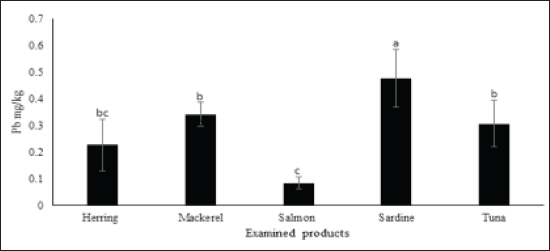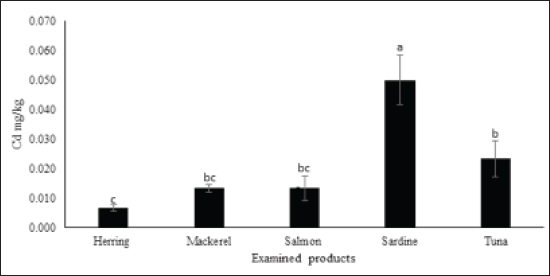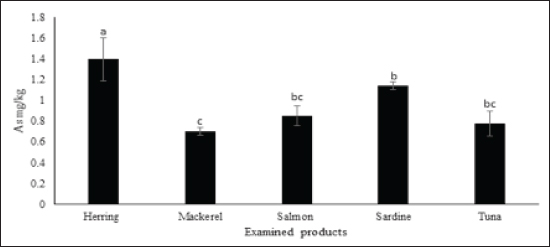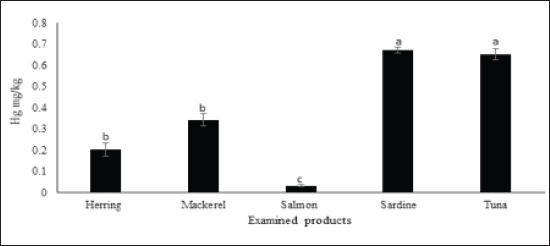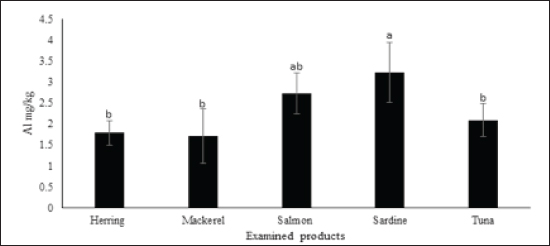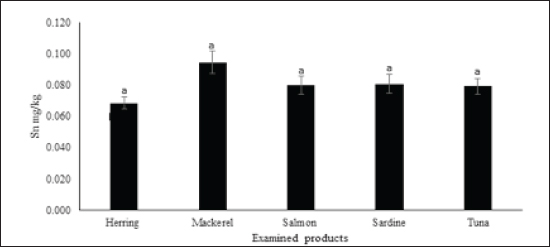
| Research Article | ||
Open Veterinary Journal, (2024), Vol. 14(1): 266-273 Original Research Risk assessment of some toxic metals in canned fish products retailed in Mansoura, EgyptMohamed A. Hussein1, Samar E. Morgan1, Abdallah F. Mahmoud1 and Waleed R. El-Ghareeb1,2*1Food Hygiene, Safety and Technology Department, Faculty of Veterinary Medicine, Zagazig University, Zagazig, Egypt 2Department of Public Health, College of Veterinary Medicine, King Faisal University, Al Hofuf, Saudi Arabia *Corresponding Author: Waleed R. El-Ghareeb. Department of Public Health, College of Veterinary Medicine, King Faisal University, Al Hofuf, Saudi Arabia. Email: welsaid [at] kfu.edu.sa Submitted: 01/10/2023 Accepted: 15/12/2023 Published: 31/01/2024 © 2024 Open Veterinary Journal
ABSTRACTBackground: Canned fish products are widely consumed in Egypt, particularly for protein-rich meals that are quick to prepare and low in calories. Canned fish products are contaminated with toxic metals from the fish itself or from canning materials during processing. Aim: To determine the residual levels of cadmium (Cd), lead (Pb), arsenic (As), mercury (Hg), aluminum (Al), and Tin (Sn) in some canned fish products obtained from retail shops in Mansoura, Egypt. Furthermore, noncarcinogenic health risks evaluation for the Egyptian population due to hazardous metal oral intake. Methods: One hundred canned fish products (20 each of herring, mackerel, salmon, sardine, and tuna) were collected from May to September 2023, and canned fish products were obtained from Mansoura city markets in Egypt. Samples were digested in a solution composed of 60% nitric acid and 40% perchloric acid, and then an atomic absorption spectrophotometer was used for the detection of selected toxic metals. Results: It was found that the residual level of hazardous metals exceeded the acceptability level established in the European Union for Pb, Cd, and Hg by 20%, 10%, and 10%, 15%, 5%, and 20%, 35%, 30%, and 45%, 25%, 25%, and 40%, in examined herring, mackerel, sardine, and tuna, respectively. In contrast, all salmon samples were accepted for Pb and Hg, and only 5% were not accepted due to a higher Cd level than the maximum permissible limit. The average estimated daily intake of (EDI) is below the tolerable daily intakes (TDIs) for all metals. Comparatively, the EDI of Hg was 0.265 µg/kg body weight (B.W) exceeded TDIs 0.228 µg/kg B.W. The hazard index for canned tuna and sardines is more than one. Conclusion: Canned fish products are contaminated with a variety of toxic metals, especially sardine and tuna. Therefore, it is advised to decrease the consumption rate of such fish products. Keywords: Toxic metals, Canned fish, Risk. IntroductionFish can provide more than 50% of high-quality protein, minimal fat, polyunsaturated essential fatty acids, and micro and macronutrients. World population growth has exceeded fish production due to the increased consumption rate, which has grown per capita globally since 2017 (World Data Statistics, 2017). In Egypt, while addressing the issue of red meat scarcity, fish offers consumers low prices of high biological value animal protein (Ahmed et al., 2013; Hussein et al., 2019). Dietary intakes and risk evaluation of biogenic amine accumulation in fish were studied (El-Ghareeb et al., 2021). Despite the high nutritional value of fish, over eating seafood products can have detrimental health effects on consumers due to heavy metal accumulation in fish muscles from the water in which reared (Castro-González and Méndez-Armenta, 2008). Heavy metals are a major contaminant of the aquatic environment due to their high levels of persistence in the ecosystem and toxicity to marine animals. Human exposure to hazardous metals has increased dramatically over the last 50 years due to an exponential increase in the use of heavy metals in industrial processes and products (Fu and Xi, 2020). According to Sarmiento et al. (2011), even very low metal concentrations can be harmful to the health of terrestrial and aquatic creatures, including people. Depending on the stage of development, age, and other physiological parameters, the distribution of metals varies amongst fish species. Fish can be a significant dietary source of mercury for humans since they have high quantities of the element in their tissues. The major source of mercury and arsenic for people is fish. Humans are known to be toxic to mercury, and eating fish is one of the main ways that people get mercury exposure. A hazardous issue for human health is the biotransformation of mercury and the creation of methyl mercury (Khansari et al., 2005). In Egypt, the fish canning business has grown significantly, and locally made canned fish items are sold widely in Egyptian markets. The fish canning process varies depending on the product being canned, and the size, and shape of the container, but there are generally a few basic steps that are followed, the most important of which is selecting and preparing raw materials for processing to produce a product that meets quality control standards. Industrialization has improved life quality and general technology, but it has also increased metal concentrations in water (Morshdy et al., 2013). The current investigation attempted to determine the residual level of a hazardous metal in canned fish products obtained from retail shops in Mansoura, Egypt. Furthermore, noncarcinogenic health risk evaluation for the Egyptian population due to hazardous metal oral intake. Materials and MethodsSample collectionOne hundred canned fish products (20 each of herring, mackerel, salmon, sardine, and tuna) were collected from May to September 2023, canned fish products obtained from Mansoura city fish market in Egypt. Canned fish products were picked from cans that appeared to be normal, with no signs of exterior or internal spoilage. Sample preparationSample preparation was according to Finerty et al. (1990) briefly; 1 g of flesh is obtained by using a sterile can opener, and then homogenized for 12 hours in 5 ml of (60% nitric acid and 40% perchloric acid) as digestion solution. The solution was then warmed for 3 hours at 70°C in a water bath while being stirred every 30 minutes. After being diluted with 20 ml of double distilled water and kept at 20°C, the filter paper was used in the filtration of the digested mixture and kept until the determination of toxic metals. Analysis of metalsLead, cadmium, aluminum, and tin were detected with Perkin Elmer atomic absorption spectrophotometer (AAS) PinAAcleTM 900T. While arsenic and mercury were analyzed by hydride generation/cold vapor (AAS). Quality controlDORM-3 fish obtained from (NRC) were used to ensure the accuracy of the processes. The limit of detection (µg/g) for “lead, cadmium, arsenic, mercury, aluminum, and tin were 0.01, 0.005, 0.02, 0.01, 0.1, and 0.02 for each element.” The metal levels detected were indicated in [µg/g wet weight (WW)]. Estimated daily intake (EDI)The US EPA (2017) stated that EDI (µg/kg/day)=Cm × FIR/body weight (B.W) was used to compute the EDI of different metals that consumers intake through ingestion of fish products, where Cm is the mean of the examined element (µg/g WW)”. In addition, FAO (2010) stated, “food ingestion rate per capita for adults set at 48.57 g.” B.W in adult Egyptian is fixed at 70 kg. Health risk assessmentAccording to US EPA (2010), the (HQ) of the analyzed metals was calculated “HQ=EDI/RFD × 10−3. For lead, cadmium, arsenic, mercury, aluminum, and tin the RFD is 0.004, 0.001, 0.0003, 0.0005, 1, and 0.0003 mg/kg/day.” The US EPA (2017) stated the following equation for Hazard index (HI) to quantify the danger of combined metals HI=target hazard quotient (THQ) of (lead + cadmium + arsenic + mercury + aluminum + tin). Statistical analysisThe statistical analysis was assessed using ANOVA the post-hoc test and the Turkey. Significant data was defined as a p-value of 0.05. The data (SD) were expressed using the means and standard deviation (SAS, 2008). Ethical approvalNot needed for this study. ResultsThe obtained values in Figure 1 cleared that Pb residues were detected in all canned fish products. The canned sardine samples had significantly higher Pb residue 0.477 ± 0.11 mg/kg, than canned mackerel (0.341 ± 0.09 mg/kg), canned tuna (0.307 ± 0.10 mg/kg), canned herring (0.227 ± 0.09 mg/kg), and canned salmon (0.083 ± 0.02 mg/kg). The cadmium was 0.050 ± 0.008 mg/kg WW in canned sardine had significantly (p < 0.05) higher Cd residues. Meanwhile, canned herring contained significantly (p < 0.05) lower Cd (0.007 ± 0.002 mg/kg WW) as shown in Figure 2. All examined canned fish products contained As with mean values 1.39 ± 0.20, 0.702 ± 0.03, 0.85 ± 0.09, 1.14 ± 0.03, and 0.77 ± 0.12 in canned herring, mackerel, salmon, sardine, and tuna, respectively (Fig. 3). The Hg residue was significantly lower (p < 0.05) in canned salmon 0.033 ± 0.004, mg/kg. The ascending Hg level belongs to canned herring, then canned mackerel, then canned tuna, and finally canned sardine 0.203 ± 0.03, 0.343 ± 0.05, 0.653 ± 0.04, and 0.673 ± 0.07 mg/kg, respectively (Fig. 4). The mean values of Al residues were 1.797 ± 0.28, 1.707 ± 0.34, 2.73 ± 0.31, 3.22 ± 0.43, and 2.097 ± 0.28 mg/kg in canned herring, mackerel, salmon, sardine, and tuna, respectively (Fig. 5). The Sn residues were 0.069 ± 0.004, 0.095 ± 0.005, 0.080 ± 0.003, 0.081 ± 0.004, and 0.079 ± 0.003 mg/kg in canned herring, mackerel, salmon, sardine, and tuna, respectively (Fig. 6). When the satisfactoriness of the tested samples was compared to the acceptability of EC, it was distinct that four (20%), three (15%), seven (35%), and five (25%), of the canned herring, mackerel, sardine, and tuna, respectively, more than the maximum permissible limit (MPL) (0.3 mg/kg ww) for lead in fish on comparing with European Commission’s (2006). Meanwhile, two (10%), one (5%), two (10%), six (30%), and five (25%), respectively, of the canned herring, mackerel, salmon, sardine, and tuna exceeded the Cd residue limit (0.05 mg/kg ww). Meanwhile, two (10%), three (15%), nine (45%), and eight (40%), respectively, of the canned herring, mackerel, sardine, and tuna exceeded the European Commission’s (2006) MPL of 0.5 mg/kg ww. as shown in Table 1.
Fig. 1. Lead mean values (mg/kg ww) in canned fish products. Different little letter columns are significant.
Fig. 2. Cadmium mean values (mg/kg ww) in canned fish products. Different little letter columns are significant.
Fig. 3. Arsenic mean values (mg/kg ww) in canned fish products. Different little letter columns are significant.
Fig. 4. Mercury mean values (mg/kg ww) in canned fish products. Different little letter columns are significant.
Fig. 5. Aluminium mean values (mg/kg ww) in canned fish products. Different little letter columns are significant.
Fig. 6. Tin mean values (mg/kg ww) in canned fish products. Different little letter columns are significant. Table 2 shows that the EDI of toxic metals from canned fish product eating was lower than the tolerable daily intake (TDIs) for examined metals except for Hg, which was higher than the adjusted TDI (0.228 µg/kg B.W) as 0.238 from mackerel, 0.467 from sardine, and 0.453 µg/kg B.W from tuna consumption. The average THQ for tested metals was less than one based on EDI. Meanwhile, calculating the HI based on 10% total arsenic in fish exclusively inorganic all analyzed canned fish products below one except canned sardine (1.50) and tuna (1.34) (Table 3). Table 1. The satisfactoriness of the canned fish products according to EC standard.
Table 2. A comparison between the EĐI to TĐIs µg/kg BW.
Table 3. THQ and HI for toxic metals in canned fish products.
DiscussionExamined toxic metals such as lead, cadmium, arsenic, mercury, aluminum, and tin are known to have no physiological significance. Certain metals can cause organ damage and a variety of toxicological effects when continuously consumed, even in low quantities, due to their capabilities of bioaccumulation and biomagnification (Jaishankar et al., 2014). Lead residues detected in canned fish products worldwide as 0.03 to 8.62 mg/kg WW in China (Leung et al., 2014), 0.03 to 0.51 mg/kg WW in Kingdom Saudia Arabia (Ashraf et al., 2006), 0.16 ± 0.11 mg /kg WW in Italy (Russo et al., 2013), 0.1 0.08 mg/kg WW in Iran (Andayesh et al., 2015), and 0.01 ± 0.005 mg/kg WW in Poland (Kowalska et al., 2020). The cadmium residues were nearly similar to those previously obtained 0.02–0.06 mg/kg WW in tuna fish from China (Leung et al., 2014), and 0.01–0.06 mg/kg WW in canned tuna retailed in Italy (Russo et al., 2013), and 0.06 ± 0.01mg/kg WW in Poland (Kowalska et al., 2020). Comparatively, lower Cd residues 0.001–0.006 mg/kg WW were detected in Iran (Andayesh et al., 2015). Higher Cd residues of 0.07–0.64 mg/kg WW were reported in canned fish marketed in the KSA (Ashraf et al., 2006). Lower levels of As residues were detected from 0.03 to 1.53 mg/kg WW in China (Leung et al., 2014), from 0.25 to 1.42 mg/kg WW in Iran (Andayesh et al., 2015), and from 0.96 ± 0.29 mg/kg WW in Poland (Kowalska et al., 2020). This could be because the technique used in this study detects total arsenic, even though inorganic arsenic concentrations the most hazardous kind are more important to consider when it comes to human food. Still, fish and fish products have very low levels of inorganic arsenic (Molin et al., 2015). The primary chemical forms of arsenic in fish are arsenobetaine and arsenocholine, which are rapidly and unmetabolized eliminated in human urine, and are thought to be nontoxic (Francesconi, 2010). The mercury values in this study were comparable to Hg in canned fish retailed in Brazil at0.41 mg/kg WW (Morgano et al., 2014). Meanwhile, much lower Hg was detected in Italy at 0.05 ± 0.05 mg/kg WW (Russo et al., 2013), in Iran at 0.06–0.16 mg/kg WW (Andayesh et al., 2015), and in Poland at 0.06 ± 0.009 mg/kg WW (Kowalska et al., 2020). Pregnant women and young kids should exercise extra caution when exposed to mercury since mercury stunts brain development (Sheehan et al., 2014). This study also employed a careful methodology, assuming that mercury in the fish was methylmercury, which is substantially more toxic than metallic mercury, which is frequently detected in fish. Usually, 80%–100% of the total Hg in fish is accounted for by methylmercury (EFSA Panel on Contaminants in the Food Chain, 2012). The data obtained demonstrate the species differences in the bioaccumulation of toxic metals; for example, salmon had the lowest amounts of various metals, while sardine and tuna had the greatest residual quantities. This may depend on the fish’s place in the food chain because tuna fish, which are predatory fish, collect higher concentrations of heavy metals (Hussein et al., 2023). The high concentrations of lead, mercury, and arsenic in the tested products indicate either the fish’s lifelong exposure to these metals or contamination of the canning materials or post-processing (Morshdy et al., 2021). Aluminum is the most common metal in nature and, by extension, in food. However, throughout time, anthropogenic actions and soil acidity have led to an increase in Al levels. Al is considered a hazardous material because it accumulates in the brain. Al levels and a number of illnesses, including Alzheimer’s disease, have been linked in numerous studies. In addition, aluminum might interfere with some significant metals (Sjögren et al., 2007). The obtained Al residues were nearly similar to the finding of 4.76 ± 4.37 and 7.22 ± 1.62 mg/kg WW in canned tuna from Lebanon and Egypt (Al Ghoul et al., 2020; Morshdy et al., 2021). Increased exposure to tin and its constituents has been linked to harmful side effects, including neurological issues, gastrointestinal issues, lung irritation, and ocular irritation (Boogaard et al., 2003). Consuming seafood, juice, or other liquid goods packaged in tin-lined cans exposes humans to tin and its compounds, such as organotin. Unlacquered tin-lined cans, which have a tin content of up to 100 parts per million, are particularly high in tin (Graf, 2000). The obtained tin values in the current study were slightly lower than the Sn values obtained in fish products in Poland 0.12 ± 0.01 mg/kg WW (Kowalska et al., 2020). There were no significant differences (p < 0.05) between examined canned fish products which may attributed to the main is leaching of Sn from the tin-coat into the fish product. Assessment of health risksCanned fish products contribute 5.575%, 1.480%, 32.158%, 1.123%, and 0.009% of TDIs from lead, cadmium, arsenic, aluminum, and tin, respectively. Meanwhile, the consumption of canned fish products contributes to 116.049% of TDIs in the case of Hg, which indicates possible hazards according to the suggested TDIs of the World Health Organization (2010). The total As from fish consumption is not important but, only inorganic chemical forms of arsenic are considered (ATSDR, 2005). In addition, 10% of the As were thought to be inorganic in the worst-case scenario (US EPA, 2002). The THQ average for lead, cadmium, arsenic, aluminum, and tin is less than 1, indicating that there are no health risks associated with consuming canned fish products. In Lebanon and Egypt, consuming canned fish resulted in almost identical innocuous THQ levels (Al Ghoul et al., 2020; Morshdy et al., 2021). The mixed contaminants HI for salmon (0.453) < herring (0.809) < mackerel (0.927) < tuna (1.341) < sardine (1.504) falls within the average (1.007) in an ascending order. This suggests that consuming too much-canned fish could be harmful to consumers’ health. As a result, it is advised to consume canned fish products in moderation. ConclusionCertain canned fish products contain levels of hazardous metals that are beyond the allowable limits established by regulation by the European Commission. The results were lower than the (TDIs) of the toxic element, which were estimated using the means of lead, cadmium, arsenic, mercury, Al, and Sn in canned fish samples and the mean amount of fish consumed daily by individuals. The THQ is less than one. It is advised to consume canned fish products in moderation, as HI is now higher than one. AcknowledgmentNone. Conflict of interestThere is no conflict of interest, according to the authors. FundingNone. Data availabilityAll data are provided in the manuscript. ReferencesAhmed, H.A., Hussein, M.A. and El-Ashram, A.M. 2013. Seafood a potential source of some zoonotic bacteria in Zagazig, Egypt, with the molecular detection of Listeria monocytogenes virulence genes. Vet. Ital. 49(3), 299–308. Al Ghoul, L., Abiad, M.G., Jammoul, A., Matta, J. and El Darra, N. 2020. Zinc, aluminium, tin and Bis-phenol a in canned tuna fish commercialized in Lebanon and its human health risk assessment. Heliyon 6(9), e04995. Andayesh, S., Hadiani, M.R., Mousavi, Z. and Shoeibi, S. 2015. Lead, cadmium, arsenic and mercury in canned tuna fish marketed in Tehran, Iran. Food. Addit. Contam. Part. B. Surveill. 8(2), 93–98. Ashraf, W., Seddigi, Z., Abulkibash, A. and Khalid, M. 2006. Levels of selected metals in canned fish consumed in Kingdom of Saudi Arabia. Environ. Monit. Assess. 117(1–3), 271–279. ATSDR. 2005. Public health assessment guidance manual. Appendix G: calculating exposure doses. Available via http://www.atsdr.cdc.gov/hac/phamanual/appg.html (Accessed 9 March 2023). Boogaard, P.J., Boisset, M., Blunden, S., Davies, S., Ong, J.J. and Taverne, J.P. 2003. Comparative assessment of gastrointestinal irritant potency in man of tin (II) chloride and tin migrated from packaging. Food. Chem. Toxic. 41, 1663–1670. Castro-González, M.I. and Méndez-Armenta, M. 2008. Heavy metals: implications associated to fish consumption. Environ. Toxicol. Pharmacol. 26(3), 263–271. EFSA Panel on Contaminants in the Food Chain. 2012. Scientific opinion on the risk for public health related to the presence of mercury and methylmercury in food. Efsa. J. 10(12), 2985. El-Ghareeb, W.R., Elhelaly, A.E., Abdallah, K.M., El-Sherbiny, H.M. and Darwish, W.S. 2021. Formation of biogenic amines in fish: dietary intakes and health risk assessment. Food. Sci. Nutr. 9, 3123–3129. European Commission (EC). 2006. Commission of the European Communities. Commission Regulation (EC) No. 1881. Setting maximum levels contaminants in foodstuffs. Off. J. Eur. Comm. 364, 24. FAO. 2010. Nutrition country profiles—Egypt. Rome, Italy: FAO. Available via https://www.fao.org/countryprofiles/index/en/?iso3=EGY Finerty, M.W., Madden, J.D., Feagley, S.E. and Grodner, R.M. 1990. Effect of environs and seasonality on metal residues in tissues of wild and pond-raised crayfish in southern Louisiana. Arch. Environ. Contam. Toxicol. 19, 94–100. Francesconi, K.A. 2010. Arsenic species in seafood: origin and human health implications. Pure. Appl. Chem. 82(2), 373–381. Fu, Z. and Xi, S. 2020. The effects of heavy metals on human metabolism. Toxicol. Mech. Methods. 30(3), 167–176. Graf, G.G. 2000. Tin, tin alloys and tin compounds in Ullmann’s Encyclopedia of Industrial Chemistry. Weinheim, Germany: Wiley-VCH. Hussein, M.A., Merwad, A.M., Elabbasy, M.T., Suelam, I.I., Abdelwahab, A.M. and Taha, M.A. 2019. Prevalence of enterotoxigenic Staphylococcus aureus and Shiga toxin producing Escherichia coli in fish in Egypt: quality parameters and public health hazard. Vector. Borne. Zoonotic. Dis. 19(4), 255–264. Hussein, M.A., Morsy, N.S., Mahmoud, A.F., Darwish, W.S., Elabbasy, M.T., Zigo, F., Farkašová, Z. and Rehan, I. F. 2023. Risk assessment of toxic residues among some freshwater and marine water fish species. Fron. Vet. Sci. 10, 1185395. Jaishankar, M., Tseten, T., Anbalagan, N., Mathew, B.B. and Beeregowda, K.N. 2014. Toxicity, mechanism and health effects of some heavy metals. Interdiscip. Toxicol. 7(2), 60–72. Khansari, F.E., Ghazi-Khansari, M. and Abdollahi, M. 2005. Heavy metals content of canned tuna fish. Food. Chem. 93(2), 293–296. Kowalska, G., Pankiewicz, U. and Kowalski, R. 2020. Determination of the level of selected elements in canned meat and fish and risk assessment for consumer health. J. Anal. Methods. Chem. 2020, 2148794. Leung, H.M., Leung, A.O., Wang, H.S., Ma, K.K., Liang, Y., Ho, K.C., Cheung, K.C, Tohidi, F. and Yung, K.K. 2014. Assessment of heavy metals/metalloid (As, Pb, Cd, Ni, Zn, Cr, Cu, Mn) concentrations in edible fish species tissue in the Pearl River Delta (PRD), China. Mar. Pollut. Bull. 78(1–2), 235–245. Molin, M., Ulven, S.M., Meltzer, H.M. and Alexander, J. 2015. Arsenic in the human food chain, biotransformation and toxicology–review focusing on seafood arsenic. J. Trace. Elem. Med. Biol. 31, 249–259. Morgano, M.A., Rabonato, L.C., Milani, R.F., Miyagusku, L. and Quintaes, K.D. 2014. As, Cd, Cr, Pb and Hg in seafood species used for sashimi and evaluation of dietary exposure. Food. Control. 36, 24–29. Morshdy, A.E., Hafez, A.E., Darwish, W.S., Hussein, M.A. and Tharwat, A.E. 2013. Heavy metal residues in canned fishes in Egypt. Jpn. J. Vet. Res. 61(Suppl), S54–S57. Morshdy, A.E., Hussein, M.A., Darwish, W.S., Yousef, R.E. and Tharwat, A.E. 2021. Residual contents of selected heavy metals in commercial canned fish in Egypt: Dietary intakes and health risk assessment. Slov. Vet. Res. 58, 101–107. Russo, R., Lovoi, A., De Simone, A., Serpe, F.P, Anastasio, A., Pepe, T., Cacace, D. and Severino, L. 2013. Heavy metals in canned tuna from Italian markets. J. Food. Prot. 76(2), 355–359. Sarmiento, A.M., DelValls, A., Miguel Nieto, J., Salamanca, M.J. and Caraballo, M.A. 2011. Toxicity and potential risk assessment of a river polluted by acid mine drainage in the Iberian Pyrite Belt (SW Spain). Sci. Total. Environ. 409(22), 4763–4771. SAS. Statistical system package. 2008-Jmp 8 user’s guide, 2nd ed. Cary, NC: SAS Institute Inc, USA. ISBN. 978-1-60764-301-2. Sheehan, M.C., Burke, T.A., Navas-Acien, A., Breysse, P.N., McGready, J. and Fox, M.A. 2014. Global methylmercury exposure from seafood consumption and risk of developmental neurotoxicity: a systematic review. Bull. World. Health. Organ. 92, 254–269F. Sjögren, B., Iregren, A., Elinder, C.G. and Yokel, R.A. 2007. Chapter 17: aluminum. In Handbook on the toxicology of metals, 3rd ed. Eds., Nordberg, G.F., Fowler, B.A., Nordberg, M. and Friberg, L. Amsterdam, The Netherlands: Academic Press. US EPA. 2002. Supplemental guidance for developing soil screening levels for superfund sites office of solid waste and emergency response; OSWER9355.4-24. Washington, DC: US EPA. US EPA. 2010. Integrated risk information system (IRIS). CASRN-7440-43-9. Washington, DC: US EPA. Available via http://www.epa.gov/iris/subst/0141.htm US EPA. 2017. Human health risk assessment. Washington, DC: US EPA. Available via https://www.epa.gov/risk/hu-man-health-risk-assessment (Accessed 02 March 2018). World Data Statistics. 2017. Fish and sea food consumption in the world. Available via http://www.ourworldindata.org World Health Organization. 2010. Evaluation of certain food additives and contaminants. 37th report of the Joint FAO/WHO Expert Committee on Food Additives. WHO technical report series. Geneva, Switzerland: World Health Organization. | ||
| How to Cite this Article |
| Pubmed Style Hussein MA, Morgan SE, Mahmoud AF, El-Ghareeb WR, . Risk assessment of some toxic metals in canned fish products retailed in Mansoura, Egypt. Open Vet J. 2024; 14((1) (Zagazig Veterinary Conference)): 266-273. doi:10.5455/OVJ.2024.v14.i1.23 Web Style Hussein MA, Morgan SE, Mahmoud AF, El-Ghareeb WR, . Risk assessment of some toxic metals in canned fish products retailed in Mansoura, Egypt. https://www.openveterinaryjournal.com/?mno=177165 [Access: May 08, 2024]. doi:10.5455/OVJ.2024.v14.i1.23 AMA (American Medical Association) Style Hussein MA, Morgan SE, Mahmoud AF, El-Ghareeb WR, . Risk assessment of some toxic metals in canned fish products retailed in Mansoura, Egypt. Open Vet J. 2024; 14((1) (Zagazig Veterinary Conference)): 266-273. doi:10.5455/OVJ.2024.v14.i1.23 Vancouver/ICMJE Style Hussein MA, Morgan SE, Mahmoud AF, El-Ghareeb WR, . Risk assessment of some toxic metals in canned fish products retailed in Mansoura, Egypt. Open Vet J. (2024), [cited May 08, 2024]; 14((1) (Zagazig Veterinary Conference)): 266-273. doi:10.5455/OVJ.2024.v14.i1.23 Harvard Style Hussein, M. A., Morgan, S. E., Mahmoud, A. F., El-Ghareeb, W. R. & (2024) Risk assessment of some toxic metals in canned fish products retailed in Mansoura, Egypt. Open Vet J, 14 ((1) (Zagazig Veterinary Conference)), 266-273. doi:10.5455/OVJ.2024.v14.i1.23 Turabian Style Hussein, Mohamed A., Samar E. Morgan, Abdallah F. Mahmoud, Waleed R. El-Ghareeb, and . 2024. Risk assessment of some toxic metals in canned fish products retailed in Mansoura, Egypt. Open Veterinary Journal, 14 ((1) (Zagazig Veterinary Conference)), 266-273. doi:10.5455/OVJ.2024.v14.i1.23 Chicago Style Hussein, Mohamed A., Samar E. Morgan, Abdallah F. Mahmoud, Waleed R. El-Ghareeb, and . "Risk assessment of some toxic metals in canned fish products retailed in Mansoura, Egypt." Open Veterinary Journal 14 (2024), 266-273. doi:10.5455/OVJ.2024.v14.i1.23 MLA (The Modern Language Association) Style Hussein, Mohamed A., Samar E. Morgan, Abdallah F. Mahmoud, Waleed R. El-Ghareeb, and . "Risk assessment of some toxic metals in canned fish products retailed in Mansoura, Egypt." Open Veterinary Journal 14.(1) (Zagazig Veterinary Conference) (2024), 266-273. Print. doi:10.5455/OVJ.2024.v14.i1.23 APA (American Psychological Association) Style Hussein, M. A., Morgan, S. E., Mahmoud, A. F., El-Ghareeb, W. R. & (2024) Risk assessment of some toxic metals in canned fish products retailed in Mansoura, Egypt. Open Veterinary Journal, 14 ((1) (Zagazig Veterinary Conference)), 266-273. doi:10.5455/OVJ.2024.v14.i1.23 |





